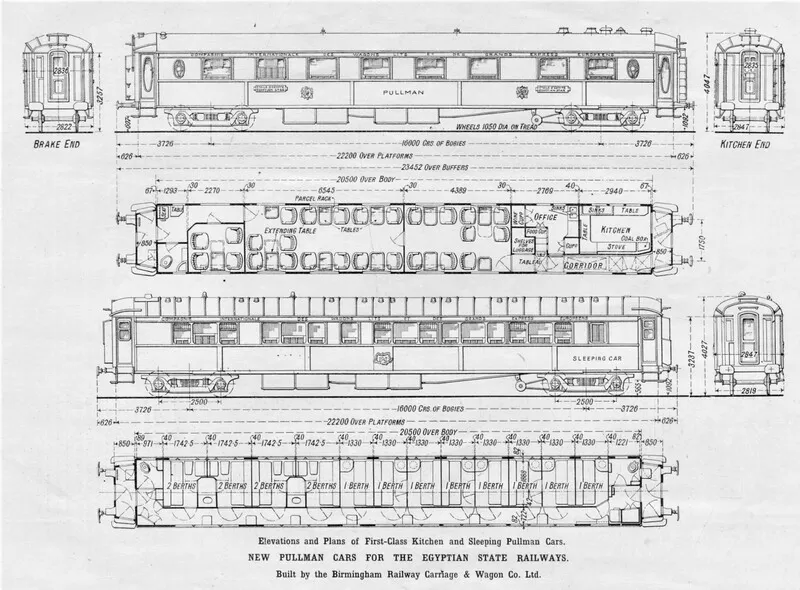WPC 4171 - 4176
Also known as:
Pullman
Vehicle type:
Registration country:
1928
The 6x units from this series are built in 1928.
The under-frames of the car are of the Wagons-Lits type, having a strong longitudinal centre girder built up of plates and angles. This is rigidly connected to the ends of the frames, which are of cast steel designed in one piece to form a complete frame from the bogie centre to the headstock. The crossbars are of pressed steel and the sole-bars of rolled steel of "Z" section. The buffing and drawgear is of the Wagons-Lits standard type "Chevalier and Rey" system, the shocks being taken up by laminated springs, equalising beams being fitted to the buffer shoes. The brakes are of the vacuum type with additional hand brake. The bogies are the Wagons-Lits standard equalising beam type, the frame consisting of a single steel casting, the bolster and spring plank also being of cast steel. The body shell is constructed entirely of steel with pressed-steel pillars, window frames and roof carlines. The window openings are formed of light steel pressings, and all joints in the panelling are covered with rolled-steel round-edge mouldings. The ends of the car are constructed in a similar manner to the sides. The whole of the outside and floor plates are of "copper bearing steel". The roof plates are backed inside with canvas to prevent drumming. Insulation is carried out by means of "Celotex", one layer being attached to the inside of the side panelling and another to the exterior panelling. Two layers of "Celotex", with an air space between, are fixed in the roof. The flooring is comprised of corrugated galvanised sheets riveted direct to the under-frame, the depressions formed by the corrugations being filled in with a bitumastic compound. On top of this steel floor, thick slabs of compressed cork are placed, the whole being covered by linoleum. Carpets are also provided. The result is seen in a resilient sound-deadening floor, which is very effective in keeping out exterior traffic noises.
The under-frames of the car are of the Wagons-Lits type, having a strong longitudinal centre girder built up of plates and angles. This is rigidly connected to the ends of the frames, which are of cast steel designed in one piece to form a complete frame from the bogie centre to the headstock. The crossbars are of pressed steel and the sole-bars of rolled steel of "Z" section. The buffing and drawgear is of the Wagons-Lits standard type "Chevalier and Rey" system, the shocks being taken up by laminated springs, equalising beams being fitted to the buffer shoes. The brakes are of the vacuum type with additional hand brake. The bogies are the Wagons-Lits standard equalising beam type, the frame consisting of a single steel casting, the bolster and spring plank also being of cast steel. The body shell is constructed entirely of steel with pressed-steel pillars, window frames and roof carlines. The window openings are formed of light steel pressings, and all joints in the panelling are covered with rolled-steel round-edge mouldings. The ends of the car are constructed in a similar manner to the sides. The whole of the outside and floor plates are of "copper bearing steel". The roof plates are backed inside with canvas to prevent drumming. Insulation is carried out by means of "Celotex", one layer being attached to the inside of the side panelling and another to the exterior panelling. Two layers of "Celotex", with an air space between, are fixed in the roof. The flooring is comprised of corrugated galvanised sheets riveted direct to the under-frame, the depressions formed by the corrugations being filled in with a bitumastic compound. On top of this steel floor, thick slabs of compressed cork are placed, the whole being covered by linoleum. Carpets are also provided. The result is seen in a resilient sound-deadening floor, which is very effective in keeping out exterior traffic noises.
Sources: https://ec64.pagesperso-orange.fr/CIWL.htm, The Railway Gazette (January 11th, 1929)
Do you have additional informations regarding this vehicle?
Help us writing the history of WPC 4171 - 4176! Your knowledge is precious for us and the entire community, do not hesitate to share your facts, photos or videos:
Latest update on the 18th of April 2021 at 17:52
Contributor(s): Tudor C.
Discussion forum




